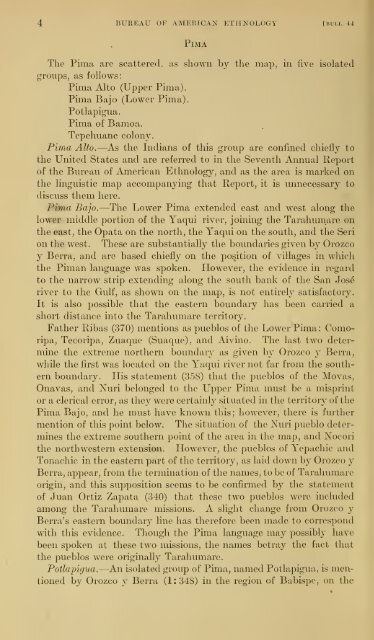Untitled - Smithsonian Institution
Untitled - Smithsonian Institution
Untitled - Smithsonian Institution
You also want an ePaper? Increase the reach of your titles
YUMPU automatically turns print PDFs into web optimized ePapers that Google loves.
4 BUREAU OF AMERICAN ETHNOLOGY [bull. 44<br />
Pima<br />
The Pima are scattered, as shown by the map, in five isolated<br />
groups, as follows:<br />
Pima Alto (Upper Pima).<br />
Pima Bajo (Lower Pima).<br />
Potlapigiia.<br />
Pima of Bamoa.<br />
Tepehuane colony.<br />
Pima Alto.—As the Indians of this group are confined chiefly to<br />
the United States and are referred to in the Seventh Annual Report<br />
of the Bureau of American Ethnology, and as the area is marked on<br />
the linguistic map accompanying that Report, it is unnecessary to<br />
discuss them here.<br />
Pima Bajo.—The Lower Pima extended east and west along the<br />
lower middle portion of the Yaqvii river, joining the Tarahumare on<br />
the east, the Opata on the north, the Yaqui on the south, and the Seri<br />
on the west. These are substantially the boundaries given by Orozco<br />
y Berra, and are based chiefly on the position of villages in which<br />
the Piman language was spoken. However, the evidence in regard<br />
to the narrow strip extending along the south bank of the San Jose<br />
river to the Gulf, as shown on the map, is not entirely satisfactory.<br />
It is also possible that the eastern boundary has been carried a<br />
short distance into the Tarahumare territory.<br />
Father Ribas (370) mentions as pueblos of the Lower Pima: Como-<br />
ripa, Tecoripa, Zuaque (Suaque), and Aivino. The last two determine<br />
the extreme northern boundary as given by Orozco y Berra,<br />
while the first was located on the Yaqui river not far from the southern<br />
boundary. His statement (358) that the pueblos of the Movas,<br />
Onavas, and Nuri belonged to the Upper Pima must be a misprint<br />
or a clerical error, as they were certainly situated in the territory of the<br />
Pima Bajo, and he must have known this; however, there is further<br />
mention of this point below. The situation of the Nuri pueblo determines<br />
the extreme southern point of the area in the map, and Nocori<br />
the northwestern extension. However, the pueblos of Yepachic and<br />
Tonachic in the eastern part of the territory, as laid down by Orozco y<br />
Berra, appear, from the termination of the names, to be of Tarahumare<br />
origin, and this supposition seems to be confirmed by the statement<br />
of Juan Ortiz Zapata (340) that these two pueblos were included<br />
among the Tarahumare missions. A slight change from Orozco y<br />
Berra's eastern boundary line has therefore been made to correspond<br />
with this evidence. Though the Pima language may possibly have<br />
been spoken at these two missions, the names betray the fact that<br />
the pueblos were originally Tarahumare.<br />
Potlapigua.—An isolated group of Pima, named Potlapigua, is men-<br />
tioned by Orozco y Berra (1:348) in the region of Babispe, on the

















